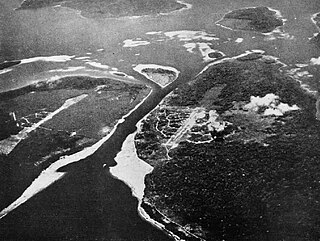
Bougainville, officially the Autonomous Region of Bougainville, is an autonomous region in Papua New Guinea. The largest island is Bougainville Island, while the region also includes Buka Island and a number of outlying islands and atolls. The interim capital is Buka, though it is expected that major government services and buildings will be moved to Arawa, following reconstruction.

Bougainville Island is the main island of the Autonomous Region of Bougainville of Papua New Guinea. It formed the main landmass of the German Empire-associated North Solomons. Its land measures 9,300 km2 (3,600 sq mi). The population of the province is approximately 300,000, which includes islets such as the Carterets. Mount Balbi on the main island at 2,715 m (8,907 ft) is the highest point. Much smaller Buka Island, c. 500 km2 (190 sq mi) lies north across the 400–500 m (1,300–1,600 ft) wide Buka strait. The Buka strait, despite its narrowness, is unbridged; however, regular ferries operate between the key settlements on either side and Buka Town has the main northern airstrip/airport.

The Battle of Empress Augusta Bay, on 1–2 November 1943 – also known as the Battle of Gazelle Bay, Operation Cherry Blossom, and in Japanese sources as the Sea Battle off Bougainville Island (ブーゲンビル島沖海戦) – was a naval battle fought near the island of Bougainville in Empress Augusta Bay. The naval battle was a result of Allied landings on nearby Bougainville in the first action in the Bougainville campaign of World War II and may also be considered as part of the Solomons and New Guinea campaigns. The battle was significant as part of a broader Allied strategy—known as Operation Cartwheel—aimed at isolating and surrounding the major Japanese base at Rabaul. The intention was to establish a beachhead on Bougainville, within which an airfield would be built.

USS McKean (DD-90/APD-5) was a Wickes-class destroyer in the United States Navy during World War II. She was the first ship named in honor of William Wister McKean.
Bougainville Copper Limited (BCL) is a mining company of Papua New Guinea (PNG) that is listed on the Australian Securities Exchange (ASX). BCL operated the copper, gold and silver mine at the Panguna mine on Bougainville Island in PNG from 1971 to 1989. Mining operations were officially halted on 15 May 1989, due to militant activity and the mine has remained closed since.

Panguna is a town and a copper mine on Bougainville Island, Papua New Guinea. It was owned and operated by Bougainville Copper Ltd, a subsidiary of Rio Tinto. Beginning operations in 1972, the company hired thousands of workers, most from other parts of the country.
Cape Torokina is a promontory at the north end of Empress Augusta Bay, along the central part of the western coast of Bougainville, in Papua New Guinea.

The Northern Solomons were the more northerly group of islands in the Solomon Islands archipelago over which Germany declared a protectorate in 1885. Initially the German Solomon Islands Protectorate included in the south-east Choiseul, Santa Isabel and the Shortlands with highly northern, vast, mainly water Ontong Java Atoll that in 1900 were conferred to the British Solomon Islands Protectorate. Greatest of the region, Bougainville, continued under German administration until World War I when it fell to Australia, and after the war, it formally passed to Australian jurisdiction under a League of Nations mandate.

The Torokina River is a river on Bougainville Island, within the Autonomous Region of Bougainville, in northeastern Papua New Guinea.
Jaba River is a river in Bougainville, Papua New Guinea. It empties to Empress Augusta Bay at 6.3833333°S 155.2166667°E. It was polluted by waste from the Panguna copper mine. Jaba river was polluted with sediments and heavy metals dumped from Copper mine. The aquatic life of Jaba river was destroyed due to heavy metal pollution. The environmental pollution of river was one of the causes of armed conflict on the island and struggle of local people for independence.
Torokina is a coastal village on Bougainville Island, in the Autonomous Region of Bougainville, eastern Papua New Guinea. It is administered under Torokina Rural LLG.

Sentarō Ōmori, was an admiral in the Imperial Japanese Navy during World War II.

The Landings at Cape Torokina, also known as Operation Cherryblossom, took place at the beginning of the Bougainville campaign in World War II. The amphibious landings were carried out by elements of the United States Marine Corps in November 1943 on Bougainville Island in the South Pacific, as part of Allied efforts to advance towards the main Japanese base around Rabaul under Operation Cartwheel. Coming in the wake of Allied successes at Guadalcanal and in the central Solomons, the landings were intended to secure a beachhead with the purpose of establishing several bases from which to project air and naval power closer towards Rabaul, in an effort to neutralize the large Japanese force that had been established there.

Arawa is the largest town and the former capital of the Autonomous Region of Bougainville in Papua New Guinea. It is administered under Arawa Rural LLG.

Buin is a town on Bougainville Island, and the capital of the South Bougainville District, in the Autonomous Region of Bougainville, in eastern Papua New Guinea. The island is in the northern Solomon Islands Archipelago of the Melanesia region, in the South Pacific Ocean.

Central Bougainville District is a district of the Autonomous Region of Bougainville of Papua New Guinea. Its capital is Arawa-Kieta.

South Bougainville District is a district of the Autonomous Region of Bougainville of Papua New Guinea. Its capital is Buin. South Bougainville languages are spoken in the district.
The Hongorai River is a river on the southern coast of Bougainville Island.

Buka Passage is a narrow strait that separates Buka Island from the northern part of Bougainville Island, within the Autonomous Region of Bougainville of northeastern Papua New Guinea.
The Atara River is a river on southeastern Bougainville Island.













